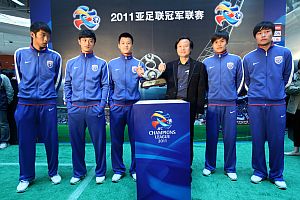Asian Football Feast editor Paul Williams writes a column for the Auisie version of the popular footie mag FourFourTwo. He posted on there earlier this week a thought-provoking piece about the ACL in which he pointed out that most groups in the eastern region of the competition have been pretty samey over the last few years. Namely, most consist of one team from China, South Korea, Japan and Australia. Add in a couple of random teams from perhaps Indonesia or occasionally South East Asia, and you have a fairly predictable formula. Indeed, Shenhua have already crossed swords with all of their current ACL group H opponents, Suwon, Kashima and Sydney, at least once in the past four years.
This rather uninspiring state of affairs, claims Asian Football Feast, is at least partly to blame for the rather medicore crowds in East Asia for most ACL games. The Editor has to agree with this. Due to stringent Asian Football Confederation standards, the actual spread of clubs able to qualify for the ACL is very narrow. Wikipedia explains how the qualifying quotas are decided for each country:
The Champions League expanded to 32 clubs and direct entry is limited to the top ten Asian leagues. Each country will receive up to 4 slots, though no more than one third of the number of teams in that country’s top division, rounded downwards, depending on the strength of their league, league structure (professionalism), marketability, financial status, and other criteria set out by the AFC Pro-League committee.
Currently, in the Eastern half of the draw, Japan, South Korea and China have four qualification spots each, whilst Australia has two on account of its league only having 12 teams. Indonesia is guaranteed one team, and it has a possible second slot via a play-off against the Thai champions.
So, as hard as it is to imagine that the Chinese Super League is ranked high enough to get the same number of teams in the ACL as Japan and Korea, and more teams that the remaining East Asian countries, that is infact how things are. It’s a quite bizarre set of circumstances. The situation in the West Asian half of the draw is not much better, where five countries hog all the spots. So what’s the solution?
Well, its understandable that the AFC want to maintain some kind of standard for the ACL – some of the stadiums in southeast Asia leave something to be desired. There’s also the question of the standard of play in places like Malaysia, Hong Kong and Singapore not being competitive with that of the current ACL teams – Vietnamese teams in particular have taken several embarassing tankings in recent years. And in some countries, such as Laos, Cambodia, Mongolia and the Phillippines, professional leagues either don’t exist or are barely functional. For such lowly football nations, there is the AFC Cup which has less stringent entrance qualifications.
However, as Asian Football Feast points out, is it really a big problem to have gaps in quality between the teams, especially seeing as such similar disparities exist in the European Champions League? And what of Singapore? Their Armed Forces team performed very well against Shenhua just two seasons ago, but now the S-League has no champions league spot. And if Indonesia is good enough to supply one team, why isn’t is good enough to supply four like China or Japan or South Korea? So many questions, but few answers are abound.
I think the ACL is moving slowly in the right direction, its done much better since it was rebranded under the “champions league” format in 2002. Japanese clubs started taking it seriously and winning it, the Australians coming in added more English language exposure and upped the general level of professionalism, and more prize and sponsorship money became available. Crucially, the winners qualifiying for the World Club Cup gives an incentive for everyone to play at least semi-meaningful games against the big boys from Europe and South America.
But in its rush to raise standards on the pitch and increase overall professionalism by restricting qualification to only a handful of leagues, the ACL is ironically doing what its counterpart in Europe does, that is, making it too difficult for clubs outside of the elite to qualify (remember Chinese Super League, J-League etc teams are elite in Asia, relatively speaking).
The ACL needs to balance things a bit better by inviting the more competitive teams from southeast Asia back to the party. Only then can it truly claim to be an all-Asia affair and help shake off some of the staleness from a tournament which, for the Eastern half of the draw at least, has become an exclusive China/South Korea/Japan /Australia club event.

